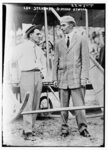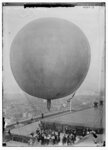Albert Leo Stevens of Cleveland was billed as “The Most Daring Aeronaut in the World.” From the time he was a teenager, he had been constructing his own hot air balloons and parachutes, …
This item is available in full to subscribers.
We have recently launched a new and improved website. To continue reading, you will need to either log into your subscriber account, or purchase a new subscription.
If you are a current print subscriber, you can set up a free website account by clicking here.
Otherwise, click here to view your options for subscribing.
Please log in to continue |
|


Albert Leo Stevens of Cleveland was billed as “The Most Daring Aeronaut in the World.” From the time he was a teenager, he had been constructing his own hot air balloons and parachutes, raising himself up into the sky and jumping back to the earth below.
Stevens regularly performed all over the country to awed audiences. In 1896, each member of a huge crowd that assembled in Portland, Maine paid twenty-five cents to watch him ascend one mile above the ground and shoot off red fireworks from the amazing height. He was known for never losing his sense of calm during his daredevil stunts, whether he was riding in a balloon lost in a windstorm, attempting to maneuver through pitch darkness or shimmying up and down ropes to makes repairs in midair.
Eventually it wasn’t merely those who craved entertainment who were vying for the attention of Stevens – the United States government was highly impressed with his capabilities. Between 1905 and 1908, the US Army was training its troops in an aerial surveillance program at Fort Omaha in Nebraska. In 1907, the US War Department hired Stevens to teach aeronautics to the soldiers in the program. In addition, he would be contracted to build hot air balloons for the government.
That first year of his employment, Stevens created a balloon named “#10”. It was the first balloon to ever be utilized by our army. Government officials referred to as a “war machine” and Secret Service men guarded the area of West Point where it was being constructed. Weighing 286 pounds and measuring 56 feet in diameter, the balloon was powered by hydrogen gas and had a lifting capacity of one ton. One of the biggest balloons Stevens had ever made, the cost to America was $12,000. He went on to make additional balloons for the government to be used in experiments concerning signals, bombs and explosives.
By 1910, it seemed that everyone wanted a piece of Stevens’s knowledge and ability. Professor David Todd, a professor in the astronomical department of Amherst College, had become certain that there was life on Mars and that our ability to communicate with that life force was impeded by a cloud layer. He therefore proposed to Stevens that they construct a balloon which would carry them above the cloud layer at a point in time when Mars was closest to earth. With wireless receiving instruments, they would then attempt to make contact with Martians. Stevens was willing to go on board, both figuratively and physically.
It was expected that the Mars ascension would take about six hours. Plans called for Stevens and Todd to be seated in chairs within airtight aluminum tanks with oxygen supplied by cranking an apparatus. In order for the experiment to be successful, they would need to ascend ten miles above earth. The highest anyone had gone in a balloon up until that time was eight miles. Of the two men who embarked on the stunt, one died and one was paralyzed. The experiment was extremely dangerous but Stevens wasn’t deterred.
As the Mars connection, which was never launched, was being planned, Stevens continued to take on other ventures. In November of 1910, he brought his personal balloon named “The Cleveland” with him to North Adams, Mass. where he agreed to take four young college students on an ascension. Williams College, a private liberal arts college for men in Williamstown, Mass. supplied the adventurous specimens. On the morning of Nov. 19, the five of them rose in the balloon. After they reached a height of 5,000 feet, a gale began blowing 120 miles per hour. Stevens knew he had to land the balloon and he had do it very carefully.
As his creation flew through the sky, carried by angry winds, it had traveled about 225 miles when Stevens sighted the Simmonsville Reservoir below. The most daring aeronaut in the world knew that unless he made some quick decisions, they would all plummet into the water below. It was just about 2:30 in the afternoon when Stevens forced the balloon to land in the midst of 65-mile-per-hour winds in the Johnston village of Simmonsville. When the basket suspended from the balloon struck the ground one of the college students was thrown from it and became temporarily unconscious but everyone survived the ride.
By 1917, Stevens was chief instructor at the Fort Omaha Army Balloon School. That year, one of the school’s balloons broke free from its moorings and Stevens chased it relentlessly. Despite the risk of being crushed if it came down on him, the fearless man was determined to reclaim his creation and he did so.
Stevens died on May 8, 1944 having experienced life from a perspective that most people never get to see.
Kelly Sullivan is a Rhode Island columnist, lecturer and author.
Comments
No comments on this item Please log in to comment by clicking here